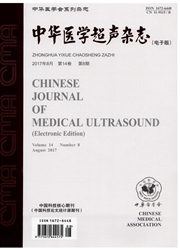

 中文摘要:
中文摘要:
目的评价声辐射力脉冲弹性成像(ARFI)声触诊组织成像定量(VTIQ)剪切波弹性成像技术鉴别诊断乳腺肿块良恶性的应用价值。方法回顾性分析2014年6至7月同济大学附属第十人民医院行超声检查的乳腺肿块患者60例共60个乳腺肿块。所有肿块均经手术病理证实。首先对所有患者行乳腺常规超声检查,观察并记录肿块大小、边界、部位、回声、内部血供等,并进行乳腺影像报告和数据系统(BI-RADS)分类。然后应用VTIQ技术测量病灶内部横向剪切波速度(SWV)。以BI-RADS分类≥4类为乳腺恶性肿块诊断标准,BI-RADS〈4为乳腺良性肿块诊断标准。以病理结果作为金标准,计算BI-RADS分类鉴别诊断乳腺肿块良恶性的敏感度、特异度、准确性、阳性预测值、阴性预测值及Youden指数。采用t检验比较乳腺良恶性肿块的SWV值差异。绘制VTIQ技术鉴别诊断乳腺肿块良恶性的操作者工作特性(ROC)曲线。结果 60个乳腺肿块包括乳腺恶性病灶18个,均为浸润性导管癌;乳腺良性病灶42个,包括纤维腺瘤21个,腺病16个,腺病伴导管扩张2个,导管内乳头状瘤1个,良性分叶状肿瘤1个,乳头状瘤1个。BI-RADS分类鉴别诊断乳腺肿块良恶性的敏感度、特异度、准确性、阳性预测值、阴性预测值、Youden指数分别为88.8%、59.5%、68.3%、48.5%、92.6%、0.48。乳腺恶性肿块平均SWV值高于乳腺良性肿块平均SWV值,且差异有统计学意义[(6.35±1.59)m/s vs(2.28±0.64)m/s,t=9.14,P〈0.001)。ROC曲线显示,VTIQ技术测得的SWV值鉴别诊断乳腺肿块良恶性的阈值为4.20 m/s,VTIQ技术鉴别诊断乳腺肿块良恶性的敏感度、特异度、准确性、阳性预测值、阴性预测值、Youden指数分别为94.4%、66.6%、75.0%、54.8%、96.5%、0.61。结论与BI-RADS分类比较,VTIQ技术能明显提高乳腺肿块良恶性的鉴别诊断能力。
 英文摘要:
英文摘要:
Objective To evaluate the diagnostic value of the novel virtual touch tissue imaging quantification(VTIQ) technique of acoustic radiation force impulse(ARFI) elastography in the differential diagnosis between benign and malignant breast lesions. Methods The imaging data of 60 pathologically proven breast masses in 60 patients at the Tenth People's Hospital of Tongji University were retrospectively analyzed from June to July in 2014. The breast lesions were first examined by conventional ultrasound. The size, boundary, internal echogenicity, and blood supply were observed and recorded, and then the lesions were classified by Breast Imaging Reporting And Data System(BI-RADS). The average shear wave velocity(SWV) value was obtained from multiple SWV measurements under the VTIQ speed mode. BI-RADS ≥ 4 was defined as the malignant standard and BI-RADS 4 as the benign standard for differential diagnosis. According to the pathological results, the sensitivity, specificity, accuracy, positive predictive value, negative predictive value, and Youden index of breast masses with BI-RADS were obtained. SWV values of benign and malignant breast tumors were compared by ttest. The receiver operating characteristic curve of VTIQ technique for differential diagnosis of benign and malignant breast masses was drawn. Results In 60 breast tumors, there were 18 malignant lesions(18 infiltrating ductal carcinomas) and 42 benign lesions(21 fibroadenoma, 16 adenosis, 2 adenosis with ductal dilatation, 1 intraductal papilloma, 1 benign phyllodes tumor and 1 papillary tumor). The sensitivity, specificity, accuracy, positive predictive value, negative predictive value, and Youden index of BI-RADS were 88.8%, 59.5%, 68.3%, 48.5%, 92.6%, and 0.48, respectively. The average SWV value of malignant breast masses was higher than that of benign breast masses, and the difference was statistically significant [(6.35±1.59) m/s vs(2.28 ± 0.64) m/s, t=9.14, P〈0.001]. The cut-off value of VTIQ SWV was 4.2 m/s accor
 同期刊论文项目
同期刊论文项目
 同项目期刊论文
同项目期刊论文
 期刊信息
期刊信息
